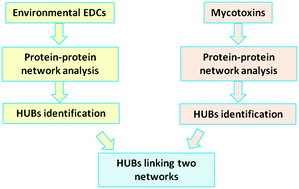当前位置:
X-MOL 学术
›
Mol. Biosyst.
›
论文详情
Our official English website, www.x-mol.net, welcomes your feedback! (Note: you will need to create a separate account there.)
An interaction network approach to study the correlation between endocrine disrupting chemicals and breast cancer
Molecular BioSystems Pub Date : 2017-10-20 00:00:00 , DOI: 10.1039/c7mb00489c Andrea Polo 1, 2, 3, 4 , Chiara Nittoli 4, 5, 6, 7, 8 , Anna Crispo 1, 2, 3, 4 , Teresa Langastro 3, 4, 9, 10, 11 , Stefania Cocco 3, 4, 12, 13 , Lorella Severino 4, 5, 6, 7, 8 , Michelino De Laurentiis 3, 4, 12, 13 , Gennaro Ciliberto 4, 11, 14, 15, 16 , Maurizio Montella 1, 2, 3, 4 , Alfredo Budillon 3, 4, 9, 10, 11 , Susan Costantini 3, 4, 9, 10, 11
Molecular BioSystems Pub Date : 2017-10-20 00:00:00 , DOI: 10.1039/c7mb00489c Andrea Polo 1, 2, 3, 4 , Chiara Nittoli 4, 5, 6, 7, 8 , Anna Crispo 1, 2, 3, 4 , Teresa Langastro 3, 4, 9, 10, 11 , Stefania Cocco 3, 4, 12, 13 , Lorella Severino 4, 5, 6, 7, 8 , Michelino De Laurentiis 3, 4, 12, 13 , Gennaro Ciliberto 4, 11, 14, 15, 16 , Maurizio Montella 1, 2, 3, 4 , Alfredo Budillon 3, 4, 9, 10, 11 , Susan Costantini 3, 4, 9, 10, 11
Affiliation

|
Endocrine disrupting chemicals (EDCs) are natural or synthetic exogenous substances affecting human health. Although present at low concentrations in the environment, they can cause a broad range of negative effects on the endocrine functions by mimicking the action of steroid hormones due to their structural similarity. Hormonal unbalance can play an important role in carcinogenesis at any stage of disease. In the case of the breast cancer, EDCs directly affect the transformation of normal breast cells into cancer cells by interfering with hormonal regulation and by inducing the alteration of factors that regulate gene expression. The principal aims of this work were to study the interaction networks of proteins modulated in breast cancer by either environmental EDCs or mycotoxins, and to identify the proteins with the strongest coordination role defined as hub nodes. Our studies evidenced the presence of seven and six hub proteins in two EDCs and mycotoxins networks, respectively. Then, by merging the two networks, we identified that three hub nodes (BCL2, ESR2 and CTNNB1) in the environmental EDCs network show direct interactions with three hub nodes (CASP8, RELA and MKI67) in the mycotoxins network. These data highlighted that two networks are linked through proteins involved in the apoptosis regulation and in processes related to cell proliferation and survival, and, thus, in breast cancer progression.
中文翻译:

相互作用网络方法研究内分泌干扰物与乳腺癌之间的相关性
破坏内分泌的化学物质(EDC)是影响人类健康的天然或合成外源物质。尽管它们以低浓度存在于环境中,但由于其结构相似性,它们可通过模拟类固醇激素的作用而对内分泌功能造成广泛的负面影响。在疾病的任何阶段,激素失衡都可以在癌变过程中发挥重要作用。对于乳腺癌,EDC通过干扰荷尔蒙调节并诱导调节基因表达的因子改变,直接影响正常乳腺癌细胞向癌细胞的转化。这项工作的主要目的是研究环境EDC或霉菌毒素在乳腺癌中调节的蛋白质相互作用网络,并鉴定出具有最强协调作用的蛋白质,即枢纽节点。我们的研究证明了分别在两个EDC和霉菌毒素网络中存在七个和六个中枢蛋白。然后,通过合并这两个网络,我们确定了环境EDC网络中的三个集线器节点(BCL2,ESR2和CTNNB1)显示了与霉菌毒素网络中的三个集线器节点(CASP8,RELA和MKI67)的直接交互。这些数据强调了两个网络通过参与细胞凋亡调节以及与细胞增殖和存活相关的过程相关的蛋白质相互联系,从而参与了乳腺癌的发展。环境EDC网络中的ESR2和CTNNB1)显示了与霉菌毒素网络中的三个集线器节点(CASP8,RELA和MKI67)的直接交互。这些数据强调了两个网络通过参与细胞凋亡调节以及与细胞增殖和存活相关的过程相关的蛋白质相互联系,从而参与了乳腺癌的发展。环境EDC网络中的ESR2和CTNNB1)显示了与霉菌毒素网络中的三个集线器节点(CASP8,RELA和MKI67)的直接交互。这些数据强调了两个网络通过参与细胞凋亡调节以及与细胞增殖和存活相关的过程相关的蛋白质相互联系,从而参与了乳腺癌的发展。
更新日期:2017-11-21
中文翻译:

相互作用网络方法研究内分泌干扰物与乳腺癌之间的相关性
破坏内分泌的化学物质(EDC)是影响人类健康的天然或合成外源物质。尽管它们以低浓度存在于环境中,但由于其结构相似性,它们可通过模拟类固醇激素的作用而对内分泌功能造成广泛的负面影响。在疾病的任何阶段,激素失衡都可以在癌变过程中发挥重要作用。对于乳腺癌,EDC通过干扰荷尔蒙调节并诱导调节基因表达的因子改变,直接影响正常乳腺癌细胞向癌细胞的转化。这项工作的主要目的是研究环境EDC或霉菌毒素在乳腺癌中调节的蛋白质相互作用网络,并鉴定出具有最强协调作用的蛋白质,即枢纽节点。我们的研究证明了分别在两个EDC和霉菌毒素网络中存在七个和六个中枢蛋白。然后,通过合并这两个网络,我们确定了环境EDC网络中的三个集线器节点(BCL2,ESR2和CTNNB1)显示了与霉菌毒素网络中的三个集线器节点(CASP8,RELA和MKI67)的直接交互。这些数据强调了两个网络通过参与细胞凋亡调节以及与细胞增殖和存活相关的过程相关的蛋白质相互联系,从而参与了乳腺癌的发展。环境EDC网络中的ESR2和CTNNB1)显示了与霉菌毒素网络中的三个集线器节点(CASP8,RELA和MKI67)的直接交互。这些数据强调了两个网络通过参与细胞凋亡调节以及与细胞增殖和存活相关的过程相关的蛋白质相互联系,从而参与了乳腺癌的发展。环境EDC网络中的ESR2和CTNNB1)显示了与霉菌毒素网络中的三个集线器节点(CASP8,RELA和MKI67)的直接交互。这些数据强调了两个网络通过参与细胞凋亡调节以及与细胞增殖和存活相关的过程相关的蛋白质相互联系,从而参与了乳腺癌的发展。


























 京公网安备 11010802027423号
京公网安备 11010802027423号